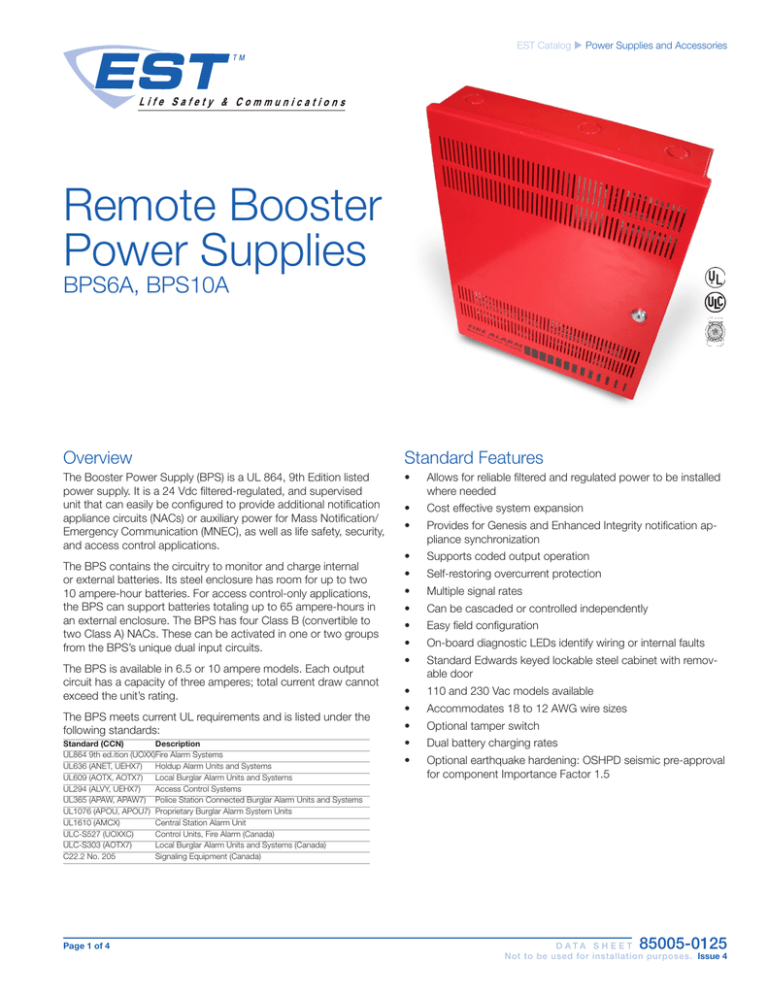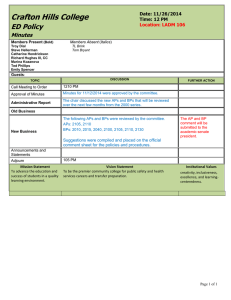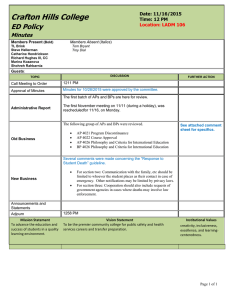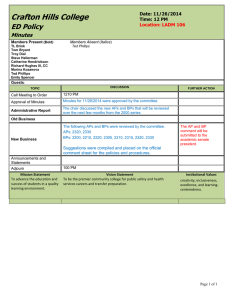
EST Catalog u Power Supplies and Accessories
Remote Booster
Power Supplies
BPS6A, BPS10A
Overview
Standard Features
The Booster Power Supply (BPS) is a UL 864, 9th Edition listed
power supply. It is a 24 Vdc filtered-regulated, and supervised
unit that can easily be configured to provide additional notification
appliance circuits (NACs) or auxiliary power for Mass Notification/
Emergency Communication (MNEC), as well as life safety, security,
and access control applications.
•
Allows for reliable filtered and regulated power to be installed
where needed
•
Cost effective system expansion
•
Provides for Genesis and Enhanced Integrity notification appliance synchronization
•
Supports coded output operation
•
Self-restoring overcurrent protection
•
Multiple signal rates
•
Can be cascaded or controlled independently
•
Easy field configuration
•
On-board diagnostic LEDs identify wiring or internal faults
•
Standard Edwards keyed lockable steel cabinet with removable door
•
110 and 230 Vac models available
•
Accommodates 18 to 12 AWG wire sizes
•
Optional tamper switch
•
Dual battery charging rates
•
Optional earthquake hardening: OSHPD seismic pre-approval
for component Importance Factor 1.5
The BPS contains the circuitry to monitor and charge internal
or external batteries. Its steel enclosure has room for up to two
10 ampere-hour batteries. For access control-only applications,
the BPS can support batteries totaling up to 65 ampere-hours in
an external enclosure. The BPS has four Class B (convertible to
two Class A) NACs. These can be activated in one or two groups
from the BPS’s unique dual input circuits.
The BPS is available in 6.5 or 10 ampere models. Each output
circuit has a capacity of three amperes; total current draw cannot
exceed the unit’s rating.
The BPS meets current UL requirements and is listed under the
following standards:
Standard (CCN)
Description
UL864 9th ed.ition (UOXX)Fire Alarm Systems
UL636 (ANET, UEHX7)
Holdup Alarm Units and Systems
UL609 (AOTX, AOTX7)
Local Burglar Alarm Units and Systems
UL294 (ALVY, UEHX7)
Access Control Systems
UL365 (APAW, APAW7) Police Station Connected Burglar Alarm Units and Systems
UL1076 (APOU, APOU7) Proprietary Burglar Alarm System Units
UL1610 (AMCX)
Central Station Alarm Unit
ULC-S527 (UOXXC)
Control Units, Fire Alarm (Canada)
ULC-S303 (AOTX7)
Local Burglar Alarm Units and Systems (Canada)
C22.2 No. 205
Signaling Equipment (Canada)
Page 1 of 4
85005-0125
D ATA S H E E T
Not to be used for installation purposes. Issue 4
Application
Dimensions
The BPS provides additional power and circuits for notification appliances and other 24 Vdc loads. It is listed for indoor dry locations
and can easily be installed where needed.
D5
Fault conditions are indicated on the on-board diagnostic LEDs,
opening the BPS input sense circuit and the trouble relay (if
programmed). While this provides indication to the host system,
the BPS can still be activated upon command. A separate AC
Fail contact is available on the BPS circuit board, which can be
programmed for trouble or AC Fail. There are seven on-board
diagnostic LEDs: one for each NAC fault, one for battery fault, one
for ground fault, and one for AC power.
BPS NACs can be configured for a 3-3-3 temporal or continuous
output. California temporal rate outputs are also available on certain models. This makes the BPS ideal for applications requiring
signaling rates that are not available from the main system.
In addition to the internally generated signal rates, the BPS can
also be configured to follow the coded signal rate of the main
system NACs. This allows for the seamless expansion of existing
NACs.
D2
D3
Side View
D4
Front View
D1
D6
Side View
The unique dual-input activation circuits of the BPS can be activated by any voltage from 6 to 45 VDC (filtered-regulated) or 11
to 33 Vdc (full-wave rectified, unfiltered). The first input circuit can
be configured to activate 1-4 of the four possible outputs. The
second input circuit can be configured to control circuits 3 and 4.
When outputs are configured for auxiliary operation, these circuits
can be configured to stay on or automatically deactivate 30 seconds after AC power is lost. This feature makes these circuits ideal
for door holder applications. The BPS also has a separate 200
mA 24 Vdc output that can be used to power internal activation
modules.
Top View
All knockouts
for 3/4 in conduit
(1.9 cm)
D1
D2
D3
D4
D5
D6
17.0 in
(43.2 cm)
3.5 in
(8.9 cm)
13.0 in
(33.0 cm)
6.5 in
(16.5 cm)
3.375 in
(8.6 cm)
12.0 in
(30.4 cm)
Wire routing
The BPS enclosure has mounting brackets for up to three Signature modules to the right of the circuit board.
Engineering Specification
Supply, where needed, Edwards BPS Series Booster Power Supplies (BPS) that are interconnected to and supervised by the main
system. The BPS shall function as a stand-alone auxiliary power
supply with its own fully-supervised battery compliment. The BPS
battery compliment shall be sized to match the requirements of
the main system. The BPS shall be capable of supervising and
charging batteries having the capacity of 24 ampere-hours for
Mass Notification/Emergency Communication (MNEC), life safety
and security applications, and the capacity of 65 ampere-hours for
access control applications.
<<The BPS shall be capable of installation for a seismic component Importance Factor of 1.5.>> The BPS shall provide a
minimum of four independent, fully supervised Class B circuits
that can be field configurable for notification appliance circuits or
auxiliary 24 Vdc power circuits. BPS NACs shall be convertible to
a minimum of two Class A NACs. Each BPS output circuit shall
be rated at 3 amperes at 24 Vdc. Each output circuit shall be
provided with automatically restoring overcurrent protection. The
BPS shall be operable from the main system NAC and/or Edwards
Signature Series control modules. BPS NACs shall be configurable
for continuous, 3-3-3 temporal or optionally, California rate. Fault
conditions on the BPS shall not impede operation of main system NAC. The BPS shall be provided with ground fault detection
circuitry and a separate AC fail relay.
Page 2 of 4
Notes
1. Maintain 1/4-inch (6 mm) spacing between power-limited and nonpower-limited
wiring or use type FPL, FPLR, or FPLP cable per NEC.
[2] Power-limited and supervised when not configured as auxiliary power. Nonsupervised when configured as auxiliary power.
[3] Source must be power-limited. Source determines supervision.
4. When using larger batteries, make sure to position the battery terminals towards
the door.
85005-0125
D ATA S H E E T
Not to be used for installation purposes. Issue 4
Typical Wiring
Single or cascaded booster
anywhere on a notification appliance circuit
To next signaling
device, booster, or
EOL resistor
NAC Circuit
NAC Circuit
Fire Alarm
Control Panel
Sense 2 Input
Sense 1 Input
Existing NAC end-of-line resistors are not required to be
installed at the booster’s terminals. This allows multiple
boosters to be driven from a single NAC circuit without the
need for special configurations.
NAC output #1
NAC output #2
NAC output #3
NAC output #4
Booster Power
Supply
Configuring the Booster for
AC Power Fail delay operation*
Notification appliance circuit (NAC)
10 9
EOL 47 kÙ
CC1(S) module [1][3]
8765
+
TB2
CT1
module [4]
Data in from previous + +
device or Signature
controller
4 321
+ +
Data in from
previous device
or Signature
controller
Data out to
next device
+
+
IN
Sense 1 COM
OUT
IN
Sense 2 COM
OUT
NO
Trouble COM
NC
EOL 47 K
+
+
UL listed
EOL 15 KW
+
+
+
200 mA AUX
Continuous
Notification appliance circuit (NAC)
+
UL listed
EOL 15 kÙ
UL listed
EOL 15 KW
+
+
+
Notification appliance circuit (NAC)
+
TB5
IN
Sense 1 COM
OUT
IN
Sense 2 COM
OUT
NO
Trouble COM
NC
Notification appliance circuit (NAC)
TB1
NAC1/
AUX1
NAC2/
AUX2
NAC3/
AUX3
NAC4/
AUX4
UL listed
EOL 15 kÙ
TB5
+
TB1
NAC1/
AUX1
NAC2/
AUX2
NAC3/
AUX3
NAC4/
AUX4
200 mA AUX
Continuous
Multiple CC1(S) modules using the
BPS’s sense inputs
EOL 47 K
+
+
10 9
10 9
CC1(S) module
TB2
Data out to
next device
8765
+ +
CC1(S) module
4 321
[1]
4 321
8765
[1]
+ +
[3]
*The Booster supports AC Power fail delay
of three hours via its trouble contact when
dip switch SW2-6 is on. All other troubles
are reported to supervising module or panel
without delay via Sense inputs.
Security and access
BPS
24 V
12 V
Security
device
24DC12
EOL
monitoring
device
Security
device
+
+
+
+
TB1
NAC1/
AUX1
NAC2/
AUX2
NAC3/
AUX3
NAC4/
AUX4
Control panel
+
[1] Disable the BPS’s ground fault jumper (JP3)
Page 3 of 4
BPS [1]
Card reader
controller
+
Card reader
controller
+
+
Card reader
controller
+
To next
device
or end
85005-0125
D ATA S H E E T
Not to be used for installation purposes. Issue 4
Specifications
Model
AC Line Voltage
Detection & alarm since 1872
Notification Appliance
Circuit Ratings
U.S.
T 888-378-2329
F 866-503-3996
Trouble Relay
Auxiliary Outputs
Canada
Chubb Edwards
T 519 376 2430
F 519 376 7258
Input Current
(from an existing NAC)
Booster Internal
Supervisory Current
Signature Mounting
Space
Maximum Battery Size
Southeast Asia
T : +65 6391 9300
F : +65 6391 9306
India
T : +91 80 4344 2000
F : +91 80 4344 2050
Australia
T +61 3 9239 1200
F +61 3 9239 1299
Europe
T +32 2 725 11 20
F +32 2 721 86 13
Latin America
T 305 593 4301
F 305 593 4300
utcfireandsecurity.com
© 2010 UTC Fire & Security.
All rights reserved.
1.
Requires installation of separate battery cabinet.
2. BPS supports batteries greater
than 24 Amp hours for access
control applications only.
3. For earthquake anchorage,
including detailed mounting
weights and center of gravity
detail, refer to Seismic Application Guide 3101676. Approval
of panel anchorage to site
structure may require local
AHJ, structural or civil engineer
review.
Ground Fault Detection
Agency Listings
1.
2.
70mA
Accomodates three two-gang modules.
10 Amp Hours (2 of 12V10A) in cabinet up to 24 Amp hours with external battery cabinet for fire and security applications; up to 65 Amp
hours for access control applications in external battery box.
18-12 AWG
0 to 93% non condensing @ 32°C
32° to 120°F (0° to 49°C)
Class A or Class B
Continuous, California rate, 3-3-3 temporal,
or follow installed panel’s NAC. (See note 1.)
Enable or Disable via jumper
UL, ULC, CSFM
Model BPS*CAA provides selection for California rate, in place of temporal.
Maximum of 8 Amps can be used for auxiliary output.
Ordering Information
Catalog
Number
BPS6A
BPS6AC
BPS6A/230
BPS6CAA
BPS10A
BPS10AC
BPS10A/230
BPS10CAA
Description
Shipping
Wt. lb (kg)
13 ( 5.9)
13 ( 5.9)
13 ( 5.9)
13 ( 5.9)
13 ( 5.9)
13 ( 5.9)
13 ( 5.9)
13 ( 5.9)
6.5 Amp Booster Power Supply
6.5 Amp Booster Power Supply (ULC)
6.5 Amp Booster Power Supply (220V)
6.5 Amp Booster Power Supply with California rate
10 Amp Booster Power Supply
10 Amp Booster Power Supply (ULC)
10 Amp Booster Power Supply (220V)
10 Amp Booster Power Supply with California rate
Related Equipment
12V6A5
7.2 Amp Hour Battery, two required
12V10A
10 Amp Hour Battery, two required
3-TAMP
Tamper switch
BC-1EQ
Seismic Kit for BC-1. Order BC-1 separately. See note 3.
BPSEQ
Seismic kit for BPS6A or BPS10 Booster Power Supplies. See
note 3
BC-1
Battery Cabinet (up to 2 - 40 Amp Hour Batteries)
BC-2
Battery Cabinet (up to 2 - 17 Amp Hour Batteries)
12V17A
18 Amp Hour Battery, two required (see note 1)
12V24A
24 Amp Hour Battery, two required (see note 1)
12V40A
40 Amp Hour Battery, two required (see notes 1, 2)
12V50A
50 Amp Hour Battery, two required (see notes 1, 2)
12V65A
65 Amp Hour Battery, two required (see notes 1, 2)
3.4 (1.6)
9.5 (4.3)
58 (26.4)
19 (8.6)
13 ( 5.9)
20 (9.07)
32 (14.5)
40 (18.14)
49 (22.2)
85005-0125
D ATA S H E E T
Not to be used for installation purposes. Issue 4
05-18-11
Page 4 of 4
Terminal Wire Gauge
Relative Humidity
Temperature Rating
NAC Wiring Styles
Output Signal Rates
6.5 amp Booster
10 amp Booster
120VAC or 220-240VAC 50/60Hz 120VAC or 220-240VAC 50/60Hz
580 watts
390 watts
3.0A max. per circuit @ 24Vdc
3.0A max. per circuit @ 24Vdc
nominal 10A max total all NACs
nominal 6.5A max total all NACs
2 Amps @ 30Vdc
Four configurable outputs replace NACs 1, 2, 3 or 4. as auxiliary
outputs and 200 mA dedicated auxiliary. (See note 2.)
3mA @ 12Vdc, 6mA @ 24Vdc





